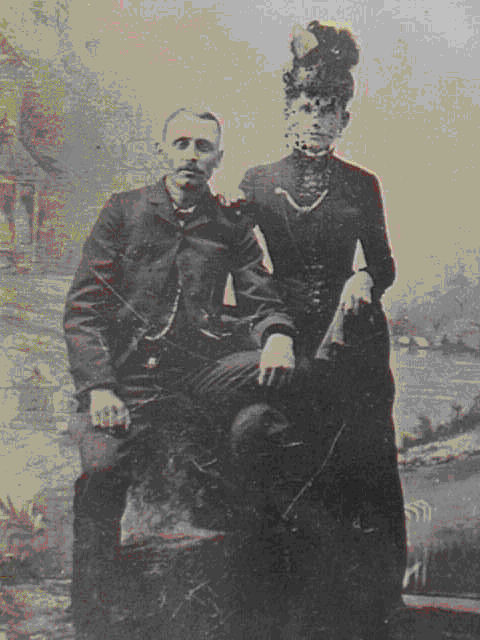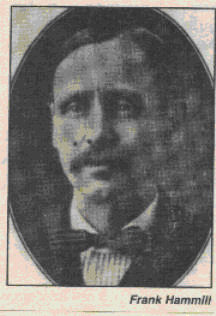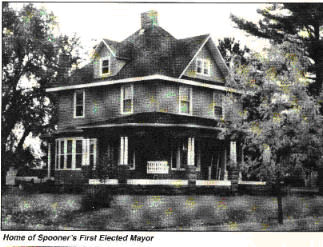
Washburn Co. WIGenWeb
| SEARCH |
People
Histories
Frank and
Helena Hammill
Written
and donated by Jack Hammell
Great-great-nephew of Frank Hammill
The eighth and last child
of Irish
immigrants Thomas and Catherine Hammill, Frank, was born on 23 December
1857 at
Parma, Michigan. He
is listed in both
the 1860 and 1870 censuses as living at home with his mother,
Catherine, in
Parma and attending school. At the age of 18, in 1875, he became a locomotive
fireman for the Michigan Central Railroad.
In 1878, he relocated to
On In 1891, Frank and Lain were living in In 1895, they were apparently farming in “Mr. Hammell has invested a good deal of his earnings in land in Plat maps for 1906 show farm acreage of more than 120 acres owned by Frank Hammill north of Cable. This acreage is in Section 6, Range 7 West, Township 43 North. The property fronted on old Highway 63 and ran west to To the north of Cable is a body of water named Hammill Lake; this lake may have received its name due to the proximity of other land holdings owned by Frank Hammill, but to date no On By 1902, Frank and Lain had returned to Spooner permanently, perhaps unable to remain on the Cable farm with its memories of little Nat and his death. They became deeply involved in the life of the small town. According to another resident, James Murphey, who was interviewed some years later, “When they built the first electric light plant, the city couldn't be assessed for more than five percent of its valuation. The five percent amounted to $11,000 and the amount of the light plant came up to $16,000, and somebody had to make up the difference until they could collect some revenue. The men who helped make up that difference were Frank Frank retired from the railroad in 1903 after twenty years due to ill health, and built a home. "The stately home on the corner of Vine and "Frank Hammill was reportedly quite exacting in what would be used in the construction of his Spooner home[9]. It is said that when he discovered imperfections in the first shipment of oak woodwork for the house, he had it quickly returned and replaced. Having friends and business interests in Frank Hammill purchased The Spooner Advocate and The Spooner Register newspapers in 1904, consolidated the papers, and remained the owner and publisher of The Spooner Advocate until his death. He declared the paper (and himself) to be politically Republican. He was elected President of the In 1909, Frank stood for election to the Wisconsin State Assembly and was elected by 4,033 votes to his opponent's 1,024 votes. He served one term in the Assembly. In 1910, the village became a city, and Frank was elected mayor and remained in that office until 1918. Frank died on Frank Hammill's widow, Lain Hammill, remained owner of "The Spooner Advocate" until 1924, when she sold the newspaper. She was a member of the “Lain lived in the house [built by her husband, Frank] until she died in February 1942. Following Mrs. Hammill's death, the house was purchased by railroad engineer Sam Brown. But Brown never lived there. While he owned it, he briefly had the house up for rent and in a classified newspaper ad described it as ‘6 room modern home, newly decorated.’ Rather than renting it, though, Brown soon decided it would be the ideal home for his fellow engineer, Charles Arthur Salmonson, and family, so he sold it instead to the Salmonsons. “They moved into the house in October 1942. More than 30 years later, Salmonson's widow, Jenny, sold the house to another Spooner railroader, James Mommsen, who moved in with his family in 1974. The Mommsens lived there until 1990 when they sold it to the present owner, Joyce Schancer. Schancer is an area antiques dealer who grew up in the neighborhood. Having admired the house for a long time, she purchased it in 1990. Since that time she has [restored] it to its original style".[13] The home still stands at
[1]
Historical
Collections of Washburn County and the Surrounding Indianhead Country, Volume 2, page 393.
[2]
See the section
on Thomas Hammill for
more
[3]
“Cable
Cullings”, a centennial
publication of the Cable Centennial Committee, page 30.
This publication is available in the Cable
Forest Lodge Library, Cable,
[4]
Ibid, page 44.
[5]
Ibid. page 54.
[6]
Historical
Collections of Washburn County and the Surrounding Indianhead Country, Volume 2, page 393.
[7] In 1942
at Lain Hammill’s death, Edith Kate Hammill inherited the
island. In 1946,
she sold the island to Kenneth A.
Bro of
[8]
Historical
Collections of Washburn County and the
Surrounding Indianhead Country,
Volume 2, pages 375-376.
[9]
On
[10]
“Spooner
Heritage Tour”, booklet
distributed by the Spooner Area Chamber of Commerce, written by Sharon
Tarr,
Historian of the City of
[11] The Spooner Cemetery
is located on the north side of US Highway 70 about two miles west of
downtown
Spooner. From the
highway, three
entrances provide access to the cemetery, and thirteen paths for
funeral vehicles
run north-south in the cemetery. The
Hammell-Kapernick family plot is located on the fifth path east of the
westernmost
entrance. It is
marked with a large
granite stone reading “Hammill” on its east face
and “Kapernick” on its west
face. Frank
Hammill, Lain Hammill and
Lain’s parents are buried on the east side of this stone,
each with an individual
stone showing the name, birth year and death year of the individual. The gravesite of Alpha
Catherine Hammill, if
she is buried here, could not be identified.
[12] The English Lutheran Church merged with a Lutheran church in Shell Lake, WI, in 1969, and is today Faith Lutheran Church (Missouri Synod) of Spooner. [13] “Spooner Heritage
Tour”, booklet distributed by the Spooner Area Chamber of
Commerce, written by
Sharon Tarr, Historian of the City of Spooner, 1998.
[14] On 19-20 May 2001,
John Hammell visited Spooner. At
that
time, the Frank Hammill home was available for sale for $156,000. The realtor provided
photos and a videotape
of the interior of the home. The
realtor, Mark Schultz of Hillside Realty, noted that this is the first
time in
its history that the home has been sold by a realtor.
All earlier transfers of the property were
between personal acquaintances.
Frank and Layne
Hammill’s home at  This photograph shows the Wisconsin State Assembly chambers in 1999. The State of Wisconsin completely renovated these chambers in 1996, and restored them to their appearance in 1909 - when Frank Hammill served here. Letter from Helena (Lain) Hammill to
her niece, Edith K. Hammill,
on the death of [Note:
to use German in the home, church and school as their primary language. heritage in the capitalization of nouns in mid-sentence, her phrases in place of complete sentences, and so on. These characteristics of the letter also reflect a mother’s grief over the loss of a young child, and add to the poignancy of this letter. Frank was
My
dear Edith,
In January he had the measles very hard. Doctor said he never saw a child have measles harder. When he got better One day he said Mamma will you pack up all my toys & put them in a box. I said Why you are getting better & will play with them again. He said Not till I get to the farm. I said of course you will right away. This made me feel bad But he was getting better. Last October [1901] when we were getting ready to leave here, the last morning he awakened early and said to me, today we leave the farm. (Yes) He said Goodby Goodby it is God’s way. His will (He) leaving the farm for good. This proved true. We laughed when I told of it at the breakfast table. Of course he repeated Mr. McKinley’s last words. It seems so strange that he would pass such remark. He was born on Easter Sunday [1897], took sick Palm Sunday, died Good Friday [1902]. He was getting along with scarlet fever when membraneous croup came in & he died. Thursday he said to me in German Mamma it is all. It is all. He then turned to Frank & in English repeated the same. At Frank’s health is not very good so we have to be real careful of him. I made him go to bed & I helped the doctors. At 3-30 AM Doctors left me and I stand there all alone with the little one until 7-45 A.M. when he breathed his last. He suffered awful the last 4 hours. How he thrashed & threw himself. He called for Papa at 5. But I knew Frank could not stand it so I staid alone. He finally said Oh Mama I can’t any more. I cant cry! I suppose he thought I did not know how he suffered. At 6 he grabbed both of my hands & said laugh laugh. Mamma why don’t you laugh. in ½ hour he said the same. And Edith I believe he see some thing that made him say this. He thought I too see it. All I did for hours was to pray. This is indeed the saddest part of our life. Of course little Alpha’s death was awful & we felt it. We were younger then. And our hopes were so bright for this little boy. He spoke the German perfect. He never spoke any thing but German to me. He would be speaking to Frank in English & when he spoke to me turned it in German. At the table the boarders would laugh to here him speak the two languages, one then the other. Nat too would laugh but kept it up. It was surprising. Not many children do this. They take the advantage when they can possibly speak English they do. But he was so proud of the German. When I came in Kindergarten He always address me in German. He has made so many real sweet things there. Write me again Aunt Lain DISCLAIMER:
No claim is made to the copyrights of the individual submitters. Data
within this website may be used for personal use only by
individuals researching their ancestry. Commercial use of this
information for profit is strictly prohibited without prior permission
of the owners. Other genealogical websites may link to this website;
however, permission is not granted to duplicate any of the contents.
Anyone contributing material for posting does so in recognition of its
free, non-commercial distribution, as well as the responsibility to
assure that no copyright is violated by the submission. This
website and its coordinator are not responsible for donations of
copyrighted material where explicit written permission has not been
granted for use.
|
|||
© Copyright 1997 - present. All rights reserved. wigenwebcc, Webmaster
This site was first established on 27 Aug 1997


